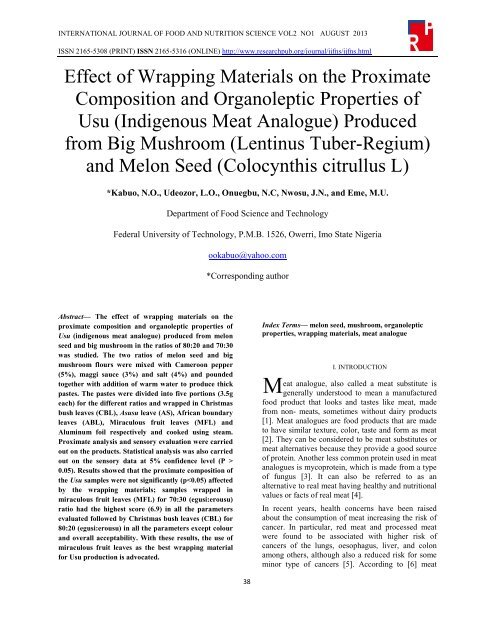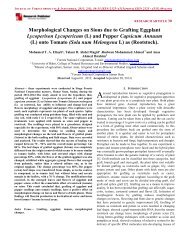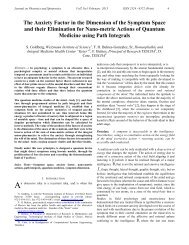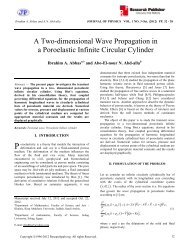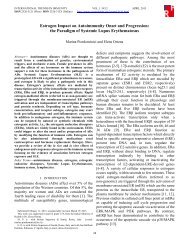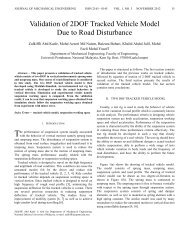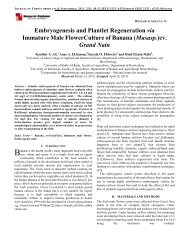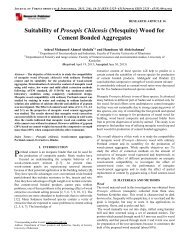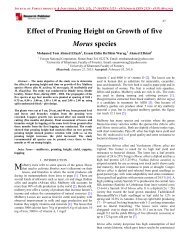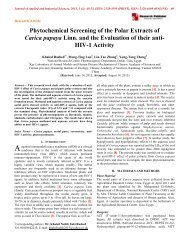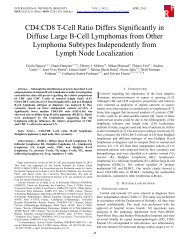Effect of Wrapping Materials on the Proximate Composition and ...
Effect of Wrapping Materials on the Proximate Composition and ...
Effect of Wrapping Materials on the Proximate Composition and ...
- No tags were found...
You also want an ePaper? Increase the reach of your titles
YUMPU automatically turns print PDFs into web optimized ePapers that Google loves.
INTERNATIONAL JOURNAL OF FOOD AND NUTRITION SCIENCE VOL2 NO1 AUGUST 2013ISSN 2165-5308 (PRINT) ISSN 2165-5316 (ONLINE) http://www.researchpub.org/journal/ijfns/ijfns.html<str<strong>on</strong>g>Effect</str<strong>on</strong>g> <str<strong>on</strong>g>of</str<strong>on</strong>g> <str<strong>on</strong>g>Wrapping</str<strong>on</strong>g> <str<strong>on</strong>g>Materials</str<strong>on</strong>g> <strong>on</strong> <strong>the</strong> <strong>Proximate</strong>Compositi<strong>on</strong> <strong>and</strong> Organoleptic Properties <str<strong>on</strong>g>of</str<strong>on</strong>g>Usu (Indigenous Meat Analogue) Producedfrom Big Mushroom (Lentinus Tuber-Regium)<strong>and</strong> Mel<strong>on</strong> Seed (Colocynthis citrullus L)*Kabuo, N.O., Udeozor, L.O., Onuegbu, N.C, Nwosu, J.N., <strong>and</strong> Eme, M.U.Department <str<strong>on</strong>g>of</str<strong>on</strong>g> Food Science <strong>and</strong> TechnologyFederal University <str<strong>on</strong>g>of</str<strong>on</strong>g> Technology, P.M.B. 1526, Owerri, Imo State Nigeriaookabuo@yahoo.com*Corresp<strong>on</strong>ding authorAbstract— The effect <str<strong>on</strong>g>of</str<strong>on</strong>g> wrapping materials <strong>on</strong> <strong>the</strong>proximate compositi<strong>on</strong> <strong>and</strong> organoleptic properties <str<strong>on</strong>g>of</str<strong>on</strong>g>Usu (indigenous meat analogue) produced from mel<strong>on</strong>seed <strong>and</strong> big mushroom in <strong>the</strong> ratios <str<strong>on</strong>g>of</str<strong>on</strong>g> 80:20 <strong>and</strong> 70:30was studied. The two ratios <str<strong>on</strong>g>of</str<strong>on</strong>g> mel<strong>on</strong> seed <strong>and</strong> bigmushroom flours were mixed with Camero<strong>on</strong> pepper(5%), maggi sauce (3%) <strong>and</strong> salt (4%) <strong>and</strong> poundedtoge<strong>the</strong>r with additi<strong>on</strong> <str<strong>on</strong>g>of</str<strong>on</strong>g> warm water to produce thickpastes. The pastes were divided into five porti<strong>on</strong>s (3.5geach) for <strong>the</strong> different ratios <strong>and</strong> wrapped in Christmasbush leaves (CBL), Asusu leave (AS), African boundaryleaves (ABL), Miraculous fruit leaves (MFL) <strong>and</strong>Aluminum foil respectively <strong>and</strong> cooked using steam.<strong>Proximate</strong> analysis <strong>and</strong> sensory evaluati<strong>on</strong> were carriedout <strong>on</strong> <strong>the</strong> products. Statistical analysis was also carriedout <strong>on</strong> <strong>the</strong> sensory data at 5% c<strong>on</strong>fidence level (P >0.05). Results showed that <strong>the</strong> proximate compositi<strong>on</strong> <str<strong>on</strong>g>of</str<strong>on</strong>g><strong>the</strong> Usu samples were not significantly (p
INTERNATIONAL JOURNAL OF FOOD AND NUTRITION SCIENCE VOL2 NO1 AUGUST 2013ISSN 2165-5308 (PRINT) ISSN 2165-5316 (ONLINE) http://www.researchpub.org/journal/ijfns/ijfns.htmlidentified using a h<strong>and</strong>book <str<strong>on</strong>g>of</str<strong>on</strong>g> West African weeds[11]. The leaves were found <strong>and</strong> collected within <strong>the</strong>envir<strong>on</strong>ment <str<strong>on</strong>g>of</str<strong>on</strong>g> Federal University <str<strong>on</strong>g>of</str<strong>on</strong>g> Technology,Owerri.C. Preliminary Preparati<strong>on</strong> <str<strong>on</strong>g>of</str<strong>on</strong>g> <strong>the</strong> <str<strong>on</strong>g>Wrapping</str<strong>on</strong>g><str<strong>on</strong>g>Materials</str<strong>on</strong>g>The wrapping materials such as miraculous fruitleaves, Christmas bush leaves, Asusu leaves <strong>and</strong>African border leaves were washed <strong>and</strong> drained.D. Cleaning <strong>and</strong> preparati<strong>on</strong> <str<strong>on</strong>g>of</str<strong>on</strong>g> <strong>the</strong> raw<str<strong>on</strong>g>Materials</str<strong>on</strong>g>The dehulled mel<strong>on</strong> seeds were manually sorted toremove <strong>the</strong> bad <strong>on</strong>es, st<strong>on</strong>es <strong>and</strong> o<strong>the</strong>r impurities <strong>and</strong>ground into flour using a manual grinder. Themushroom was peeled to remove <strong>the</strong> back, washed,dried, cut into small sizes <strong>and</strong> <strong>the</strong>n milled into flour.The Camero<strong>on</strong> pepper was also ground using <strong>the</strong>same mill.E. Producti<strong>on</strong> <str<strong>on</strong>g>of</str<strong>on</strong>g> Usu (indigenous meatanalogue)Two sets <str<strong>on</strong>g>of</str<strong>on</strong>g> samples were produced using <strong>the</strong>following ratios <str<strong>on</strong>g>of</str<strong>on</strong>g> 70:30 for <strong>the</strong> first set <strong>and</strong> 80:20for <strong>the</strong> sec<strong>on</strong>d set <strong>and</strong> <strong>the</strong> o<strong>the</strong>r ingredients in <strong>the</strong>formulati<strong>on</strong> were 5% Camero<strong>on</strong> pepper, 4% salt <strong>and</strong>3% maggi sauce. The materials were weighed outusing weighing balance <strong>and</strong> were properly blendedtoge<strong>the</strong>r by pounding in mortar <strong>and</strong> pestle with warmwater added drop by drop until a well-blendedproduct <str<strong>on</strong>g>of</str<strong>on</strong>g> good texture <strong>and</strong> c<strong>on</strong>sistency was obtained.The mixed product <str<strong>on</strong>g>of</str<strong>on</strong>g> <strong>the</strong> different ratios weremolded into small porti<strong>on</strong>s weighing 3.5g each <strong>and</strong>wrapped into Aluminium foil <strong>and</strong> four differentleaves namely Christmas bush leaves (Alchorneacordifolia), miraculous fruit leaves (Thaumatococcusdaniellii), Asusu leaves (Manniophyt<strong>on</strong> fulvum) <strong>and</strong>African border leaves (Newbouldia laevis seem) <strong>and</strong>tied with palm fr<strong>on</strong>d ropes, cooked for 90 minutesusing steam <strong>and</strong> <strong>the</strong>n cooled. The recipe used forproducti<strong>on</strong> <str<strong>on</strong>g>of</str<strong>on</strong>g> <strong>the</strong> two ratios <str<strong>on</strong>g>of</str<strong>on</strong>g> Usu samples is shownin table I. While <strong>the</strong> Flow chart for <strong>the</strong> producti<strong>on</strong> <str<strong>on</strong>g>of</str<strong>on</strong>g>indigenous meat analogue is shown in Fig. 1.TABLE IRECIPE FOR PRODUCTION OF THE USU SAMPLESIngredients First Sample (g) Sec<strong>on</strong>d sample (g)Ground Mel<strong>on</strong> seed 70 80Ground Big Mushroom 30 20Camero<strong>on</strong> Pepper 5 5Maggi Sauce 3 3Salt 4 440
INTERNATIONAL JOURNAL OF FOOD AND NUTRITION SCIENCE VOL2 NO1 AUGUST 2013ISSN 2165-5308 (PRINT) ISSN 2165-5316 (ONLINE) http://www.researchpub.org/journal/ijfns/ijfns.htmlIngredients (Ground mel<strong>on</strong> seed + Ground big mushroom + Cameroun pepper + salt + maggi)Mixing toge<strong>the</strong>r in a mortarPounding (with additi<strong>on</strong> <str<strong>on</strong>g>of</str<strong>on</strong>g> warm water drop)KneadingMolding (To small flat sizes)Packaging/wrappingCooking (With steam for 90 minutes)CoolingUsu ( Indigenous Meat Analogue)Figure 1: Flow Chart for Producti<strong>on</strong> <str<strong>on</strong>g>of</str<strong>on</strong>g> Usu (indigenous meat analogue)F. <strong>Proximate</strong> Analysis <str<strong>on</strong>g>of</str<strong>on</strong>g> ProductThe proximate compositi<strong>on</strong>s were determinedaccording to <strong>the</strong> st<strong>and</strong>ard methods <str<strong>on</strong>g>of</str<strong>on</strong>g> [12].G. Sensory Evaluati<strong>on</strong>The organoleptic evaluati<strong>on</strong> <str<strong>on</strong>g>of</str<strong>on</strong>g> <strong>the</strong> Usu samples(indigenous meat analogue) was carried out forc<strong>on</strong>sumer acceptance <strong>and</strong> preference by a 10-trainedpanelist (students <strong>and</strong> staff <str<strong>on</strong>g>of</str<strong>on</strong>g> <strong>the</strong> Department <str<strong>on</strong>g>of</str<strong>on</strong>g>Food Science <strong>and</strong> Technology, Federal University <str<strong>on</strong>g>of</str<strong>on</strong>g>Technology, Owerri, Nigeria). The panelistsevaluated <strong>the</strong> sensory properties based <strong>on</strong> colour,aroma, taste, texture <strong>and</strong> overall acceptability using anine-point Hed<strong>on</strong>ic scale, where 1 represents“extremely dislike” <strong>and</strong> 9 “extremely like”respectively described by [13].Meanwhile, necessary precauti<strong>on</strong>s were taken toprevent carryover flavour during <strong>the</strong> tasting byensuring <strong>the</strong> panelists rinsed <strong>the</strong>ir mouth with waterafter each stage <str<strong>on</strong>g>of</str<strong>on</strong>g> sensory evaluati<strong>on</strong>.H. Statistical Analysis41All <strong>the</strong> data obtained from <strong>the</strong> sensory evaluati<strong>on</strong> <strong>and</strong>proximate compositi<strong>on</strong>s were analyzed statisticallyusing <strong>the</strong> means <strong>and</strong> analysis <str<strong>on</strong>g>of</str<strong>on</strong>g> variance (ANOVA)at P ≤ 0.05. The separati<strong>on</strong> <str<strong>on</strong>g>of</str<strong>on</strong>g> means was carried outusing fisher’s Least significant difference (LSD) <strong>and</strong><strong>the</strong> significant difference <strong>and</strong> similarities <str<strong>on</strong>g>of</str<strong>on</strong>g> <strong>the</strong>samples were determined based <strong>on</strong> <strong>the</strong> scores [13].III. RESULTS AND DISCUSSIONA. <strong>Proximate</strong> Compositi<strong>on</strong>Table 2 shows <strong>the</strong> effect <str<strong>on</strong>g>of</str<strong>on</strong>g> different wrappingmaterials <strong>on</strong> <strong>the</strong> proximate compositi<strong>on</strong> <str<strong>on</strong>g>of</str<strong>on</strong>g> Ususamples (indigenous meat analogue).The table showed that <strong>the</strong> moisture c<strong>on</strong>tents <str<strong>on</strong>g>of</str<strong>on</strong>g> <strong>the</strong>samples ranged from 10.49% to 17.93% mean values.Different food materials have different capacity forabsorbing/retaining moisture which may exist asoccluded or absorbed water. Sample wrapped inAluminum foil (FIL) had <strong>the</strong> highest mean moisturevalue <str<strong>on</strong>g>of</str<strong>on</strong>g> 17.925% while <strong>the</strong> sample wrapped in Asusuleaves (AS) had <strong>the</strong> lowest mean moisture value <str<strong>on</strong>g>of</str<strong>on</strong>g>10.49%. The variati<strong>on</strong>s in <strong>the</strong> moisture c<strong>on</strong>tents <str<strong>on</strong>g>of</str<strong>on</strong>g>
INTERNATIONAL JOURNAL OF FOOD AND NUTRITION SCIENCE VOL2 NO1 AUGUST 2013ISSN 2165-5308 (PRINT) ISSN 2165-5316 (ONLINE) http://www.researchpub.org/journal/ijfns/ijfns.html<strong>the</strong>se samples could be due to variati<strong>on</strong> <str<strong>on</strong>g>of</str<strong>on</strong>g> wrappingmaterials. Since <strong>the</strong> same sample was used, <strong>the</strong> FILmay have retained more moisture than <strong>the</strong> o<strong>the</strong>rsamples during <strong>the</strong> cooking period, or <strong>the</strong> o<strong>the</strong>rmaterials may have lost moisture during cooking.The percentage mean values <str<strong>on</strong>g>of</str<strong>on</strong>g> <strong>the</strong> protein c<strong>on</strong>tents<str<strong>on</strong>g>of</str<strong>on</strong>g> <strong>the</strong> Usu samples were 15.8, 15.37. 15.69. 15.79<strong>and</strong> 14.07 for wrapping samples CBL, MFL, ABL,MF <strong>and</strong> FIL respectively.TABLE IIEFFECT OF WRAPPING MATERIALS ON PROXIMATE COMPOSITION OF “USU” AN INDIGENOUSMEAT ANALOGUE.Samples Moisture Protein Fat Crude Fibre Ash CHOCBL 13.38 a 15.8 a 25.15 a 3.78 a 5.65 a 36.28 aMFL 13.27 a 15.37 a 29.28 a 4.92 a 5.22 a 31.96 aABL 17.70 a 15.69 a 28.81 a 5.00 a 4.06 a 28.76 aMF 10.49 a 15.79 a 28.99 a 5.63 a 5.79 a 33.32 aFIL 17.93 a 14.07 a 28.70 a 4.88 a 5.65 a 31.30 aLSD 9.47 2.09 10.32 4.27 2.79 8.00Means in <strong>the</strong> same column with <strong>the</strong> same superscript are significantly similar (P < 0.05)NOTE:CBL = Christmas bush leaves (Alchornea cordifolia)MFL =Miraculous fruit leaves (Thaumatococcus daniellii),ABL = African border Leaves (Newbouldia laevis seem)AS = Asusu Leaves (Manniophyt<strong>on</strong> fulvum)FIL = Aluminum FoilThe protein c<strong>on</strong>tents were not statistically different at5% c<strong>on</strong>fidence interval, though <strong>the</strong> sample wrappedwith aluminum foil (FIL) had <strong>the</strong> lowest percentage<str<strong>on</strong>g>of</str<strong>on</strong>g> protein c<strong>on</strong>tent. Generally, <strong>the</strong> protein c<strong>on</strong>tent <str<strong>on</strong>g>of</str<strong>on</strong>g>all <strong>the</strong> samples were relatively high because, <strong>the</strong> bigmushroom <strong>and</strong> mel<strong>on</strong> used in <strong>the</strong> producti<strong>on</strong> <str<strong>on</strong>g>of</str<strong>on</strong>g> Ususamples are good sources <str<strong>on</strong>g>of</str<strong>on</strong>g> protein [14; 15; 16; 17].The fat c<strong>on</strong>tent <str<strong>on</strong>g>of</str<strong>on</strong>g> <strong>the</strong> Usu wrapped in differentwrapping materials were not significantly different (P< 0.05), although <strong>the</strong>re were differences in <strong>the</strong>irpercentage mean values ranging from 25.70% to29.28%. MFL samples had relatively high fat c<strong>on</strong>tentwhile FIL showed <strong>the</strong> lowest percentage <str<strong>on</strong>g>of</str<strong>on</strong>g> fatc<strong>on</strong>tent <strong>and</strong> this may be due to wrapping materialvariati<strong>on</strong>s as <strong>the</strong> raw leaves material used may havec<strong>on</strong>tributed to high fat c<strong>on</strong>tent <str<strong>on</strong>g>of</str<strong>on</strong>g> samples [15; 16].The ash c<strong>on</strong>tent <str<strong>on</strong>g>of</str<strong>on</strong>g> <strong>the</strong> Usu sample ranged from4.06% to 5.79% <strong>and</strong> <strong>the</strong>y were significantly similardespite slight variati<strong>on</strong> in <strong>the</strong>ir percentage meanvalue. The crude fibre c<strong>on</strong>tent followed <strong>the</strong> samepattern with percentage mean value ranging from3.78 to 5.63. There is no significant difference at 5%c<strong>on</strong>fidence interval. The carbohydrate percentagemean values ranged from 28.76 to 36.28, havingvariati<strong>on</strong>s in <strong>the</strong> value but significantly indifferent.The proximate compositi<strong>on</strong>s <str<strong>on</strong>g>of</str<strong>on</strong>g> <strong>the</strong>se samples wereso because <strong>the</strong>y were from <strong>the</strong> same mixture, <strong>the</strong>differences were from <strong>the</strong> wrapping materials.Therefore, any difference in proximate values couldbe from <strong>the</strong> wrapping materials effect.B. <str<strong>on</strong>g>Effect</str<strong>on</strong>g> <str<strong>on</strong>g>of</str<strong>on</strong>g> <str<strong>on</strong>g>Wrapping</str<strong>on</strong>g> <str<strong>on</strong>g>Materials</str<strong>on</strong>g> <strong>on</strong> <strong>Proximate</strong>Compositi<strong>on</strong> at Varying RatiosTable 3 shows <strong>the</strong> percentage mean composite values<str<strong>on</strong>g>of</str<strong>on</strong>g> Usu samples for 70:30 <strong>and</strong> 80:20 egusi: erousuratios, wrapped in different wrapping materials.From <strong>the</strong> results <str<strong>on</strong>g>of</str<strong>on</strong>g> <strong>the</strong> statistical analysis, <strong>the</strong> varyingratios <str<strong>on</strong>g>of</str<strong>on</strong>g> <strong>the</strong> Usu sample wrapped with differentwrapping materials showed no significant differencein <strong>the</strong>ir percentage moisture mean value. Sample A(70:30) had 14.87% while sample B (80:20) had14.23% respectively. The percentage protein meanvalues were 15.08% <strong>and</strong> 15.6% for samples A (70:30)<strong>and</strong> B (80:20) respectively.42
INTERNATIONAL JOURNAL OF FOOD AND NUTRITION SCIENCE VOL2 NO1 AUGUST 2013ISSN 2165-5308 (PRINT) ISSN 2165-5316 (ONLINE) http://www.researchpub.org/journal/ijfns/ijfns.htmlTABLE IVMEAN SCORES OF ORGANOLEPTIC CHARACTERISTICS OF USU SAMPLES FOR 70:30 RATIOWRAPPED IN DIFFERENT WRAPPING MATERIALSSamples Colour Aroma Taste Texture Overall AcceptabilityCBL 6.40 ±1.17 a 5.80 ± 1.48 a 6.10 ± 1.29 a 6.20 ± 1.03 a 6.90 ± 1.45 abMFL 6.90 ± 1.20 a 6.30 ±1.57 a 6.70 ± 1.16 a 6.90 ± 0.74 a 7.40 ± 0.69 aABL 6.00 ± 1.15 a 5.50 ± 0.53 a 6.60 ± 1.07 a 6.30 ± 0.48 a 6.60 ±0.84 bAS 5.70 ± 0.95 b 5.80 ± 1.62 a 6.20 ±1.62 a 6.50 ± 0.53 a 6.30 ± 0.48 bFIL 6.40 ± 1.26 a 5.70 ± 1.77 a 6.10 ± 1.59 a 6.30 ± 0.79 a 6.30 ± 1.49 bLSD 1.04 1.06 0.85 0.79 0.82Means in <strong>the</strong> same column with <strong>the</strong> same superscript are not significantly different (P < 0.05).Means in <strong>the</strong> same column with different superscript are significantly different (P > 0.05)NOTE:CBL = Christmas bush leaves (Alchornea cordifolia)MFL =Miraculous fruit leaves (Thaumatococcus daniellii),ABL = African border Leaves (Newbouldia laevis seem)AS = Asusu Leaves (Manniophyt<strong>on</strong> fulvum)FIL = Aluminum FoilThe aroma <str<strong>on</strong>g>of</str<strong>on</strong>g> all <strong>the</strong> Usu samples were significantlysimilar <strong>and</strong> <strong>the</strong>y were “slightly liked” (scoreapproximately 6.0). The aroma <str<strong>on</strong>g>of</str<strong>on</strong>g> sample wrappedwith MFL was however given <strong>the</strong> highest score 6.30,which was followed by CBL <strong>and</strong> AS having <strong>the</strong> samemean score <str<strong>on</strong>g>of</str<strong>on</strong>g> 5.80. The close rating <str<strong>on</strong>g>of</str<strong>on</strong>g> <strong>the</strong> sample <strong>on</strong>aroma could be due to <strong>the</strong> fact that <strong>on</strong>e mixture wasused in <strong>the</strong>ir producti<strong>on</strong> <strong>and</strong> <strong>the</strong> wrapping materialsdid not impart flavour <strong>on</strong> <strong>the</strong> samples.The acceptance sensory mean values for taste <str<strong>on</strong>g>of</str<strong>on</strong>g> Ususample wrapped in CBL, MFL, ABL, MF <strong>and</strong> FILwere found to be 6.40, 6.70, 6.60, 6.20 <strong>and</strong> 6.10respectively. The taste <str<strong>on</strong>g>of</str<strong>on</strong>g> all <strong>the</strong> samples weresignificantly similar, though <strong>the</strong> samples wrapped inMFL <strong>and</strong> ABL were “moderately like” (scoreapproximately 7.0) <strong>and</strong> sample wrapped in MFL wasrated <strong>the</strong> highest (score 6.70). This indicates thateven though <strong>the</strong> panelists seem to prefer MFL, <strong>the</strong>yfound <strong>the</strong> taste <str<strong>on</strong>g>of</str<strong>on</strong>g> o<strong>the</strong>rs to be quite good. Thus, <strong>the</strong>reis no significant difference in <strong>the</strong> taste despite slightvariati<strong>on</strong> in <strong>the</strong> mean value. The texture <str<strong>on</strong>g>of</str<strong>on</strong>g> all <strong>the</strong>samples were significantly similar <strong>and</strong> were ei<strong>the</strong>r“moderately liked” (score approximately 7.0) or“slightly liked” (score approximately 6.0) as rated by<strong>the</strong> panelists. The similarity in <strong>the</strong> texture could be asa result <str<strong>on</strong>g>of</str<strong>on</strong>g> proper blending <str<strong>on</strong>g>of</str<strong>on</strong>g> <strong>the</strong> ingredients as wellas <strong>the</strong> fact that <strong>the</strong> samples were obtained from <strong>the</strong>same mix <strong>and</strong> given <strong>the</strong> same cooking c<strong>on</strong>diti<strong>on</strong>s.The texture <str<strong>on</strong>g>of</str<strong>on</strong>g> <strong>the</strong> sample MFL was rated highestwith mean score <str<strong>on</strong>g>of</str<strong>on</strong>g> 6.9.The overall acceptability <str<strong>on</strong>g>of</str<strong>on</strong>g> all <strong>the</strong> samples showedthat samples wrapped in MFL were moderatelyaccepted (score approximate 7.0) <strong>and</strong> wassignificantly similar to CBL but significantlydifferent from ABL, FIL <strong>and</strong> AS which were slightlyacceptable (score approximately, 6.0). This impliesthat <strong>the</strong> sample wrapped in MFL (miraculous fruitleaves) is best accepted in all sensory parameterstested (Table IV).D. Organoleptic characteristics <str<strong>on</strong>g>of</str<strong>on</strong>g> Usu samplesfor 80:20 ratios wrapped in differentwrapping MaterialTable 5 shows <strong>the</strong> mean composite values <str<strong>on</strong>g>of</str<strong>on</strong>g> samplesfor 80:20 ratio wrapped in different wrappingmaterials. The colour <str<strong>on</strong>g>of</str<strong>on</strong>g> <strong>the</strong> sample wrapped in MFLhad mean sensory score <str<strong>on</strong>g>of</str<strong>on</strong>g> 7.10 (i.e moderately liked)<strong>and</strong> was significantly similar to CBL <strong>and</strong> ABL.These samples were significantly different from AS<strong>and</strong> FIL (scores approximately 6.0). Generally, <strong>the</strong>colour <str<strong>on</strong>g>of</str<strong>on</strong>g> all <strong>the</strong> samples were ei<strong>the</strong>r “slightly liked”(score approximately 6.0) or “moderately liked”(score approximately 7.0).44
INTERNATIONAL JOURNAL OF FOOD AND NUTRITION SCIENCE VOL2 NO1 AUGUST 2013ISSN 2165-5308 (PRINT) ISSN 2165-5316 (ONLINE) http://www.researchpub.org/journal/ijfns/ijfns.htmlTABLE VMEAN SCORES OF ORGANOLEPTIC CHARACTERISTICS OF USU SAMPLES FOR 80:20 RATIOWRAPPED IN DIFFERENT WRAPPING MATERIALSSamples Colour Aroma Taste Texture Overall AcceptabilityCBL 7.00 ± 0.82 a 6.50 ± 1.27 a 7.10 ± 0.99 a 6.70 ± 1.16 a 6.80 ± 1.55 aMFL 7.10 ± 0.88 a 6.30 ± 1.25 a 6.70 ± 1.89 a 6.40 ± 1.71 a 7.3 ± 0.67 aABL 6.60 ± 0.96 a 6.40 ± 1.26 a 6.50 ±1.51 a 6.60 ± 0.84 a 6.6 ± 1.07 aAS 6.30 ± 0.95 b 6.40 ± 0.97 a 6.50 ± 0.97 a 6.30 ± 0.82 a 6.0 ± 1.25 bFIL 6.40 ± 0.97 b 5.80 ± 1.55 a 6.50 ± 1.43 a 6.40 ± 0.84 a 6.5 ± 1.27 bLSD 0.68 0.64 0.94 0.87 0.89Means in <strong>the</strong> same column with <strong>the</strong> same superscript are not significantly different (P < 0.05).Means in <strong>the</strong> same column with different superscript are significantly different (P > 0.05)NOTE:CBL = Christmas bush leaves (Alchornea cordifolia)MFL =Miraculous fruit leaves (Thaumatococcus daniellii),ABL = African border Leaves (Newbouldia laevis seem)AS = Asusu Leaves (Manniophyt<strong>on</strong> fulvum)FIL = Aluminum FoilThe slight variati<strong>on</strong> in colour by <strong>the</strong> panelists for80:20 ratio observed in Table V is in c<strong>on</strong>s<strong>on</strong>ancewith panelists acceptance for colour in 70:30 ratioobserved in Table IV. The aroma <str<strong>on</strong>g>of</str<strong>on</strong>g> all <strong>the</strong> Ususamples were significantly similar. The aroma <str<strong>on</strong>g>of</str<strong>on</strong>g>sample wrapped with CBL was given <strong>the</strong> highestscore 6.50 (score approximately 7, i.e. “moderatelyliked”) <strong>and</strong> <strong>the</strong> sample wrapped with FIL scored 5.80(score approximately 6). The close rating <str<strong>on</strong>g>of</str<strong>on</strong>g> Ususamples <strong>on</strong> aroma could be due to <strong>the</strong> <strong>on</strong>e mixtureused in producti<strong>on</strong> <strong>and</strong> it is c<strong>on</strong>versely different from70:30 ratio samples for aroma. The sample wrappedin CBL was rated highest in terms <str<strong>on</strong>g>of</str<strong>on</strong>g> aroma (scoreapproximately 7) which was “moderately liked”. Thetaste <str<strong>on</strong>g>of</str<strong>on</strong>g> all <strong>the</strong> samples were “moderately liked”(score approximately 7.0) <strong>and</strong> insignificantlydifferent despite <strong>the</strong> mean variati<strong>on</strong>. The samplewrapped with CBL was rated highest with meanscore <str<strong>on</strong>g>of</str<strong>on</strong>g> 7.10 (score approximately 7). The texture <str<strong>on</strong>g>of</str<strong>on</strong>g>all <strong>the</strong> samples were significantly similar <strong>and</strong> wereei<strong>the</strong>r “moderately liked” (score approximately 7) or“slightly liked” (score approximately 6) with Ususample wrapped with CBL been rated highest interms <str<strong>on</strong>g>of</str<strong>on</strong>g> texture. The overall acceptability <str<strong>on</strong>g>of</str<strong>on</strong>g> all <strong>the</strong>samples showed that samples wrapped in MFL wererated highest (scoreb 6.80, i.e approximately 7.0) <strong>and</strong>was significantly similar to CBL <strong>and</strong> ABL butsignificantly different from AS <strong>and</strong> FIL which were“slightly liked” (score approximately 6.0).Thus generally, Usu wrapped with CBL (Christmasbush leaves) is best accepted in all sensoryparameters tested except in colour <strong>and</strong> overallacceptability.IV. CONCLUSIONThe organoleptic characteristics <str<strong>on</strong>g>of</str<strong>on</strong>g> <strong>the</strong> Usu samplesshowed that samples wrapped in miraculous fruitleaves (MFL) were best in almost all parameterstested including overall acceptability according to <strong>the</strong>panelists. The proximate analysis indicates thatgenerally, <strong>the</strong> different wrapping materials <strong>and</strong>variati<strong>on</strong> in ratios did not affect <strong>the</strong> proximatecompositi<strong>on</strong> <str<strong>on</strong>g>of</str<strong>on</strong>g> Usu, as <strong>the</strong> slight variati<strong>on</strong>s were dueto differences in mel<strong>on</strong> <strong>and</strong> big mushroom ratios usedin formulati<strong>on</strong>. Ratio 80:20 formulati<strong>on</strong> had highernutrient value.V. RECOMMENDATIONThe following are recommended: Miraculous fruitleaves (MFL) are <strong>the</strong> best wrapping material for Usuproducti<strong>on</strong>. The leaves are also affordable <strong>and</strong> easy toget.The 80:20 ratio is <strong>the</strong> best for Usu formulati<strong>on</strong>because <str<strong>on</strong>g>of</str<strong>on</strong>g> <strong>the</strong> high nutritive <strong>and</strong> organolepticproperties.45
INTERNATIONAL JOURNAL OF FOOD AND NUTRITION SCIENCE VOL2 NO1 AUGUST 2013ISSN 2165-5308 (PRINT) ISSN 2165-5316 (ONLINE) http://www.researchpub.org/journal/ijfns/ijfns.htmlAcknowledgement: Technical assistance <str<strong>on</strong>g>of</str<strong>on</strong>g> Dr.Owuamanam, Clifford .I is hereby acknowledged.REFERENCES[1] Wikipedia, (2012).Meat Analogue. The freeWikipediaencyclopedia.http://64.233.167.104/search.wikipedia/meat analogue. Accessed May 14,2012.[2] Soyfoods Associati<strong>on</strong> <str<strong>on</strong>g>of</str<strong>on</strong>g> North America. (2010).Soy Meat Alternative. Retrieved April 15,2010.http://www.soyfoods.org/products/soy-factsheets/soy-meat-alternative-fact-sheet[3] Center for Science in <strong>the</strong> Public Interest.Chemical Cuisine, Learn About FoodAdditives. Retrieved April 15, 2010.http://www.cspinet.org/reports/chemcuisine.htm[4] Oluba, P.K. (2005).Producti<strong>on</strong> <str<strong>on</strong>g>of</str<strong>on</strong>g> Meat analoguefrom n<strong>on</strong>-meat product.J.Fd.Sci.10(4):311-313.[5] Timothy .J.K, Liary, E.F; Margaret, T., Paul, N.A.,Valerie., Gilian. R.,Michae, L.B., Jenny,C.C., Raihir, F.B., Jan, W.K., Jim, M., <strong>and</strong>Kilm, M. (1999). Mortality. In: vegetarians<strong>and</strong> n<strong>on</strong>vegetarians, detailed findings from acollaborative analysis <str<strong>on</strong>g>of</str<strong>on</strong>g> five prospectivestudies American J. Clinical nutriti<strong>on</strong>. 70 (3):5165-5245. Retrieved 30, October 2009.[6] Patent, E.P.O. (2008). Meat Analogue.http://www.freepatent<strong>on</strong>line.com/EPO26.Accessed May15, 2012.[7] Isibor, F.U. (2010), <str<strong>on</strong>g>Effect</str<strong>on</strong>g> <str<strong>on</strong>g>of</str<strong>on</strong>g> wrapping <str<strong>on</strong>g>Materials</str<strong>on</strong>g><strong>on</strong> <strong>the</strong> organoleptic properties <str<strong>on</strong>g>of</str<strong>on</strong>g> Usu(indigenous meat analogue) Produced frombig mushroom <strong>and</strong> mel<strong>on</strong> seed. B.TechThesis. Federal University <str<strong>on</strong>g>of</str<strong>on</strong>g> TechnologyOwerri.Nigeria. Pp1-12.[8] Buddhist,C.(2008).Classificati<strong>on</strong> <str<strong>on</strong>g>of</str<strong>on</strong>g> Analogue isFood in North America.(H<strong>on</strong>gK<strong>on</strong>g).http://www.wiki/meatanalogue.org/1164.233.167.104. AccessedMay 14, 2008.[9] Lawrie, R.A. (1985). Meat Science. 4th edn.Pergam<strong>on</strong> press oxford. Pp. 36-38.[10] Hurley, J., & Liebman, B. (2006). D<strong>on</strong>’t Have aCow. Nutriti<strong>on</strong> Acti<strong>on</strong> Health Letter, 33 (6),13-15. Retrieved from Agricola, 2006, July-Aug.[11]Akobundu, I.O. <strong>and</strong> Agyakwa, C.W. (1982).Christmas bush leaves. In : A h<strong>and</strong>book <str<strong>on</strong>g>of</str<strong>on</strong>g>West – African weeds.2nd Edn. AfricanBush Builders Ltd. INTEC Printers Ibadan,Nigeria. Pp. 200-252.[12] AOAC. (1990). Official Methods <str<strong>on</strong>g>of</str<strong>on</strong>g> Analysis.16th edn. Associati<strong>on</strong> <str<strong>on</strong>g>of</str<strong>on</strong>g> <str<strong>on</strong>g>of</str<strong>on</strong>g>ficial AnalyticalChemists.2:69-88.[13] Ihekor<strong>on</strong>ye, A.I. <strong>and</strong> Ngoddy, P.O. (1985).Foodquality c<strong>on</strong>trol. In: Integrated Food ScienceTechnology for <strong>the</strong> Tropics Macmillan, Pub.Ltd L<strong>on</strong>d<strong>on</strong>. Pp. 343 – 344.[14] Tripathi, D.P. (2005). Mushrooms. In:Mushroom cultivati<strong>on</strong>. Oxford <strong>and</strong> IBHpublishers. Co. PVT.Ltd. New Delhi. Pp 10-12[15] Akubor, P.I. (1998). Physic-chemical <strong>and</strong>sensory characteristic <str<strong>on</strong>g>of</str<strong>on</strong>g> mel<strong>on</strong> seed milk. J.Food Sci. Tech. 35 (1): 93 – 95.[16] Akobundu, E.N.T, Chery, J.P. <strong>and</strong> Summ<strong>on</strong>s,J.G. (1982). Chemical, functi<strong>on</strong>al <strong>and</strong>nutriti<strong>on</strong>al properties <str<strong>on</strong>g>of</str<strong>on</strong>g> Egusi (colocynthiscrtrillus L.) seed protein products. J.Fd. Sci.47: 829 – 835.[17] Oyenuga, V.A. (1968). Nigerians food <strong>and</strong>feeding stuff. Ibadan. University press. Pp.109 –120.46


